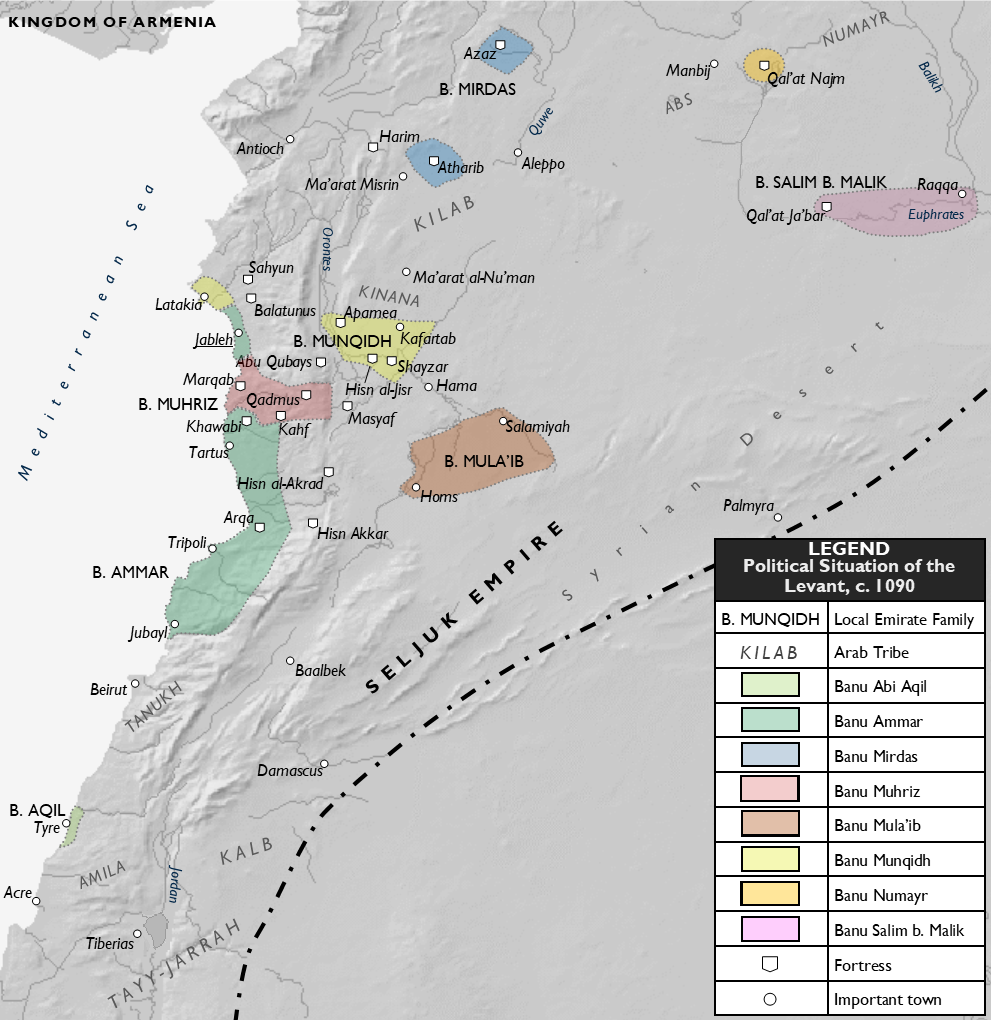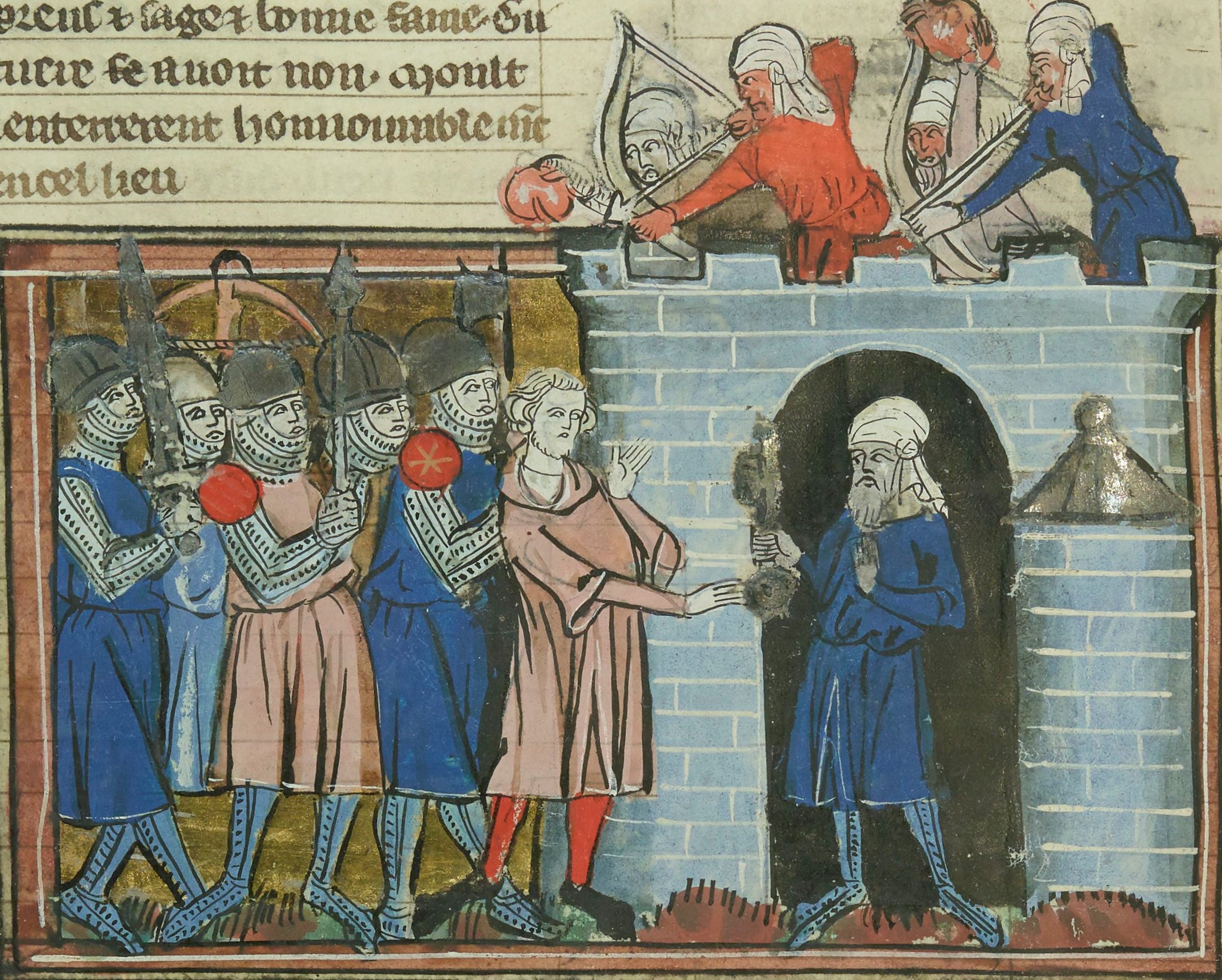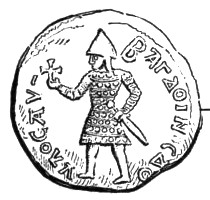|
Siege Of Tripoli
The siege of Tripoli lasted from 1102 until July 12, 1109. It took place on the site of the present day Lebanese city of Tripoli, in the aftermath of the First Crusade. It led to the establishment of the fourth crusader state, the County of Tripoli. Background After the capture of Antioch (June 1098) and the destruction of Ma'arrat al-Numan (January 13, 1099), the Syrian emirs were terrified of the advancing crusaders and quickly handed over their cities to the Franks. On January 14, Sultan ibn Munqidh, emir of Shaizar, dispatched an embassy to Raymond IV of Toulouse, one of the leaders of the crusade, to offer provisions and food for men and horses, as well as guides to Jerusalem. In February, the emir of Homs, Janah ad-Dawla, who had fought bravely at the siege of Antioch, offered horses to Raymond. The ''qadi'' of Tripoli, Jalal al-Mulk, from the Banu Ammar, sent rich gifts and invited the Franks to send an embassy to his city. The ambassadors marvelled at the splendors of t ... [...More Info...] [...Related Items...] OR: [Wikipedia] [Google] [Baidu] |
Crusades
The Crusades were a series of religious wars initiated, supported, and sometimes directed by the Latin Church in the medieval period. The best known of these Crusades are those to the Holy Land in the period between 1095 and 1291 that were intended to recover Holy Land, Jerusalem and its surrounding area from Muslim conquests, Islamic rule. Beginning with the First Crusade, which resulted in the recovery of Jerusalem in 1099, dozens of Crusades were fought, providing a focal point of European history for centuries. In 1095, Pope Pope Urban II, Urban II proclaimed the First Crusade at the Council of Clermont. He encouraged military support for List of Byzantine emperors, Byzantine emperor Alexios I Komnenos, AlexiosI against the Seljuk Empire, Seljuk Turks and called for an armed pilgrimage to Jerusalem. Across all social strata in western Europe, there was an enthusiastic response. The first Crusaders had a variety of motivations, including religious salvation, satisfying feud ... [...More Info...] [...Related Items...] OR: [Wikipedia] [Google] [Baidu] |
Banu Ammar
The Banu Ammar ( ar, بنو عمار, Banū ʿAmmār, Sons of Ammar) were a family of Shia Muslim magistrates (''qadi''s) who ruled the city of Tripoli in what is now Lebanon from c.1065 until 1109. History Accounts vary regarding the origin of Banu Ammar. While some describe them as descendants of the Kutama Berber tribe, which provided the mainstay of the early Fatimid Caliphate, other accounts describe them as members of the Arab Banu Tayy tribe. Members of the family served as qadis in Tyre 940, and in Jubayl in 990. The dynasty in Tripoli was founded by Amin al-Dawla Abu Talib al-Hasan ibn Ammar, who was the Fatimid-appointed ''qadi'' of Tripoli when the local Fatimid governor, Mukhtar al-Dawla ibn Bazzal, died circa 1065. Amin al-Dawla declared himself the independent ruler of the town, ruling a territory extending from Akkar in the north to Jubayl (Byblos) in the south. His reign was brief, as he died only two years later. Amin al-Dawla's two nephews fought for the su ... [...More Info...] [...Related Items...] OR: [Wikipedia] [Google] [Baidu] |
Crusade Of 1101
The Crusade of 1101 was a minor crusade of three separate movements, organized in 1100 and 1101 in the successful aftermath of the First Crusade. It is also called the Crusade of the Faint-Hearted due to the number of participants who joined this crusade after having turned back from the First Crusade. Calls for reinforcements from the newly established Kingdom of Jerusalem, and Pope Paschal II, successor to Pope Urban II (who died before learning of the outcome of the crusade that he had called), urged a new expedition. He especially urged those who had taken the crusade vow but had never departed, and those who had turned back while on the march. Some of these people were already scorned at home and faced enormous pressure to return to the east; Adela of Blois, wife of Stephen, Count of Blois, who had fled from the siege of Antioch in 1098, was so ashamed of her husband that she would not permit him to stay at home. Lombards As in the first crusade, the pilgrims and sold ... [...More Info...] [...Related Items...] OR: [Wikipedia] [Google] [Baidu] |
German Crusade, 1096
The Rhineland massacres, also known as the German Crusade of 1096 or ''Gzerot Tatnó'' ( he, גזרות תתנ"ו, "Edicts of 4856"), were a series of mass murders of Jews perpetrated by mobs of French and German Christians of the People's Crusade in the year 1096, or 4856 according to the Hebrew calendar. These massacres are often seen as the first in a sequence of antisemitic events in Europe which culminated in the Holocaust. Prominent leaders of crusaders involved in the massacres included Peter the Hermit and especially Count Emicho. As part of this persecution, the destruction of Jewish communities in Speyer, Worms and Mainz was noted as the ''Hurban Shum'' (Destruction of Shum). These were new persecutions of the Jews in which peasant crusaders from France and Germany attacked Jewish communities. A number of historians have referred to the violence as "pogroms". Background The preaching of the First Crusade inspired an outbreak of anti-Jewish violence. In parts of F ... [...More Info...] [...Related Items...] OR: [Wikipedia] [Google] [Baidu] |
People's Crusade
The People's Crusade was the beginning phase of the First Crusade whose objective was to retake the Holy Land, and Jerusalem in particular, from Islamic rule. After in 1095 the head of the Roman Catholic Church Pope Urban II started to urge faithful Christians to undertake an armed pilgrimage to Jerusalem, the People's Crusade was conducted for roughly six months from April to October 1096. It is also known as the Peasants' Crusade, Paupers' Crusade or the Popular Crusade as it was executed by a mainly untrained peasant army prior to the main church-organized crusade. It was led primarily by Peter the Hermit with forces of Walter Sans Avoir. The peasant army of this crusade was destroyed by the forces of the Seljuk Turks under Kilij Arslan at the Battle of Civetot in northwestern Anatolia. The People's Crusade was the first, largest, and best documented of the popular crusades. The start of the more official and fully church-backed crusade, also called the "Princes' Crusade", ... [...More Info...] [...Related Items...] OR: [Wikipedia] [Google] [Baidu] |
First Crusade
The First Crusade (1096–1099) was the first of a series of religious wars, or Crusades, initiated, supported and at times directed by the Latin Church in the medieval period. The objective was the recovery of the Holy Land from Islamic rule. While Jerusalem had been under Muslim rule for hundreds of years, by the 11th century the Seljuk takeover of the region threatened local Christian populations, pilgrimages from the West, and the Byzantine Empire itself. The earliest initiative for the First Crusade began in 1095 when Byzantine emperor Alexios I Komnenos requested military support from the Council of Piacenza in the empire's conflict with the Seljuk-led Turks. This was followed later in the year by the Council of Clermont, during which Pope Urban II supported the Byzantine request for military assistance and also urged faithful Christians to undertake an armed pilgrimage to Jerusalem. This call was met with an enthusiastic popular response across all social classes in ... [...More Info...] [...Related Items...] OR: [Wikipedia] [Google] [Baidu] |
Tancred, Prince Of Galilee
Tancred (1075 – December 5 or December 12, 1112) was an Italo-Norman leader of the First Crusade who later became Prince of Galilee and regent of the Principality of Antioch. Tancred came from the house of Hauteville and was the great-grandson of Norman lord Tancred of Hauteville. Biography Early life Tancred was a son of Emma of Hauteville and Odo the Good Marquis. His maternal grandparents were Robert Guiscard and Guiscard's first wife Alberada of Buonalbergo. Emma was also a sister of Bohemond I of Antioch. First Crusade In 1096, Tancred joined his maternal uncle Bohemond on the First Crusade, and the two made their way to Constantinople. There, he was pressured to swear an oath to Byzantine Emperor Alexius I Comnenus, promising to give back any conquered land to the Byzantine Empire. Although the other leaders did not intend to keep their oaths, Tancred refused to swear the oath altogether. He participated in the siege of Nicaea in 1097, but the city was taken by Alexius' ... [...More Info...] [...Related Items...] OR: [Wikipedia] [Google] [Baidu] |
Baldwin II Of Jerusalem
Baldwin II, also known as Baldwin of Bourcq or Bourg (; – 21August 1131), was Count of Edessa from 1100 to 1118, and King of Jerusalem from 1118 until his death. He accompanied his cousins Godfrey of Bouillon and Baldwin of Boulogne to the Holy Land during the First Crusade. He succeeded Baldwin of Boulogne as the second count of Edessa when he left the county for Jerusalem following his brother's death. He was captured at the Battle of Harran in 1104. He was held first by Sökmen of Mardin, then by Jikirmish of Mosul, and finally by Jawali Saqawa. During his captivity, Tancred, the Crusader ruler of the Principality of Antioch, and Tancred's cousin, Richard of Salerno, governed Edessa as Baldwin's regents. Baldwin was ransomed by his cousin, Joscelin of Courtenay, lord of Turbessel, in the summer of 1108. Tancred attempted to retain Edessa, but Bernard of Valence, the Latin patriarch of Antioch, persuaded him to restore the county to Baldwin. Baldwin allied with Jawali, ... [...More Info...] [...Related Items...] OR: [Wikipedia] [Google] [Baidu] |
Baldwin I Of Jerusalem
Baldwin I, also known as Baldwin of Boulogne (1060s – 2April 1118), was the first count of Edessa from 1098 to 1100, and king of Jerusalem from 1100 to his death in 1118. He was the youngest son of Eustace II, Count of Boulogne, and Ida of Lorraine and married a Norman noblewoman, Godehilde of Tosny. He received the County of Verdun in 1096, but he soon joined the crusader army of his brother Godfrey of Bouillon and became one of the most successful commanders of the First Crusade. While the main crusader army was marching across Asia Minor in 1097, Baldwin and the Norman Tancred launched a separate expedition against Cilicia. Tancred tried to capture Tarsus in September, but Baldwin forced him to leave it, which gave rise to an enduring conflict between them. Baldwin seized important fortresses in the lands to the west of the Euphrates with the assistance of local Armenians. Thoros of Edessa invited him to come to Edessa to fight against the Seljuks. Taking advantage of a rio ... [...More Info...] [...Related Items...] OR: [Wikipedia] [Google] [Baidu] |
Bertrand, Count Of Toulouse
Bertrand of Toulouse (or Bertrand of Tripoli) (died 1112) was count of Toulouse, and was the first count of Tripoli to rule in Tripoli itself. Bertrand was the eldest son of Raymond IV of Toulouse, and had ruled Toulouse since Raymond left on the First Crusade in 1095. He was, between 1098 and 1100, dispossessed by his cousin Philippa and her husband Duke William IX of Aquitaine, who marched into Toulouse and captured it. Later they mortgaged it back to Bertrand in 1100 to fund Duke William's expedition to the Holy Land. Bertrand officially became count of Toulouse when Raymond died in 1105, and in 1108 he travelled to Tripoli to take control there as well. He deposed Raymond's nephew William-Jordan as nominal count of Tripoli in 1109, and with Baldwin I, king of Jerusalem, and a fleet of Genoese ships he captured Tripoli on 12 July. Bertrand married Helie of Burgundy, daughter of Eudes I, in June 1095. Bertrand ruled in Tripoli until his death in 1112. He was succeeded by his ... [...More Info...] [...Related Items...] OR: [Wikipedia] [Google] [Baidu] |
William II Jordan
William II Jordan ( ca, Guillem Jordà; oc, Guilhèm Jordan) (died 1109) was the count of Berga beginning in 1094, the count of Cerdanya beginning in 1095, and regent of the County of Tripoli beginning in 1105. He was the son of Count William I of Cerdanya and Sança, daughter of Count Ramon Berenguer I of Barcelona. William accompanied the army of Raymond IV of Toulouse, one of the leaders of the First Crusade, to the Holy Land. Raymond died in the east in 1105, leaving his young son Alfonso-Jordan as lord of Mons Peregrinus and Tortosa (of Syria) and nominal Count of Tripoli (which had not yet been captured by the crusaders). Since Alfonso-Jordan was still a child, Raymond's soldiers chose William-Jordan as regent. Meanwhile in Toulouse, Raymond's elder son Bertrand was ruling in his absence. After Raymond's death the barons of Toulouse chose Alfonso to replace Bertrand, who, now overthrown, travelled to the east, arriving at Mons Peregrinus in 1108 to claim it for himself. ... [...More Info...] [...Related Items...] OR: [Wikipedia] [Google] [Baidu] |
Raymond IV Of Toulouse
Raymond IV, Count of Toulouse ( 1041 – 28 February 1105), sometimes called Raymond of Saint-Gilles or Raymond I of Tripoli, was a powerful noble in southern France and one of the leaders of the First Crusade (1096–1099). He was the Count of Toulouse, Duke of Narbonne and Margrave of Provence from 1094, and he spent the last five years of his life establishing the County of Tripoli in the Near East.Bréhier, Louis (1911). " Raymond IV, of Saint-Gilles". In Herbermann, Charles (ed.). ''Catholic Encyclopedia''. 12. New York: Robert Appleton Company. Early years Raymond was a son of Pons of Toulouse and Almodis de La Marche. He received Saint-Gilles with the title of "count" from his father and displaced his niece Philippa, Duchess of Aquitaine, his brother William IV's daughter, in 1094 from inheriting Toulouse. In 1094, William Bertrand of Provence died and his margravial title to Provence passed to Raymond. A bull of Urban's dated 22 July 1096 names Raymond ''comes Nimirum ... [...More Info...] [...Related Items...] OR: [Wikipedia] [Google] [Baidu] |







.jpg)
